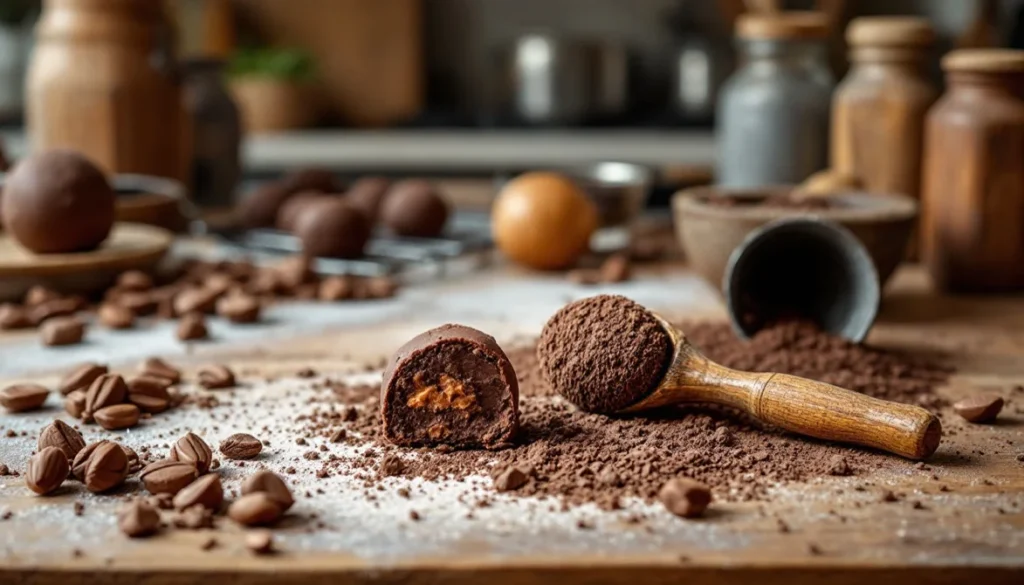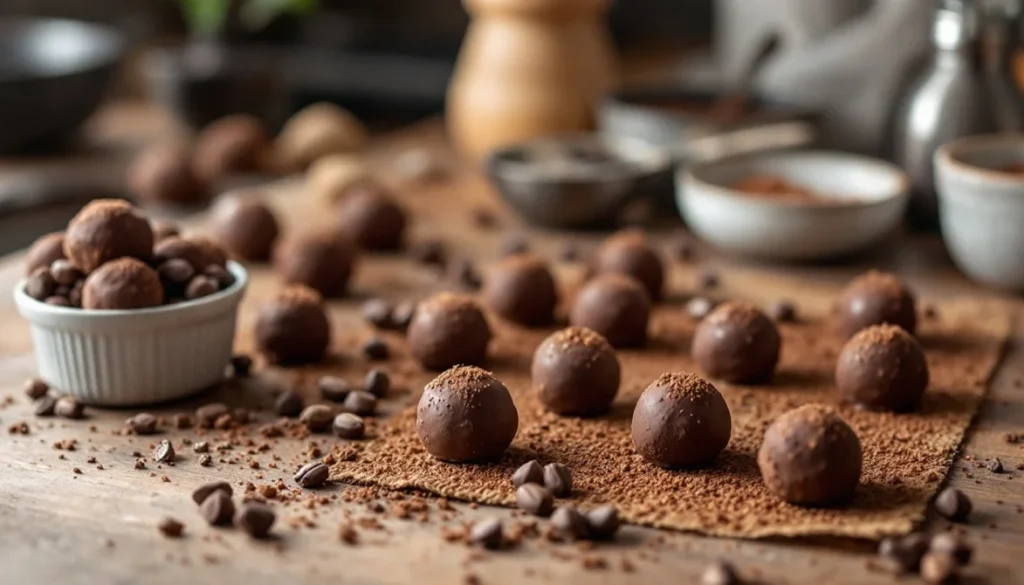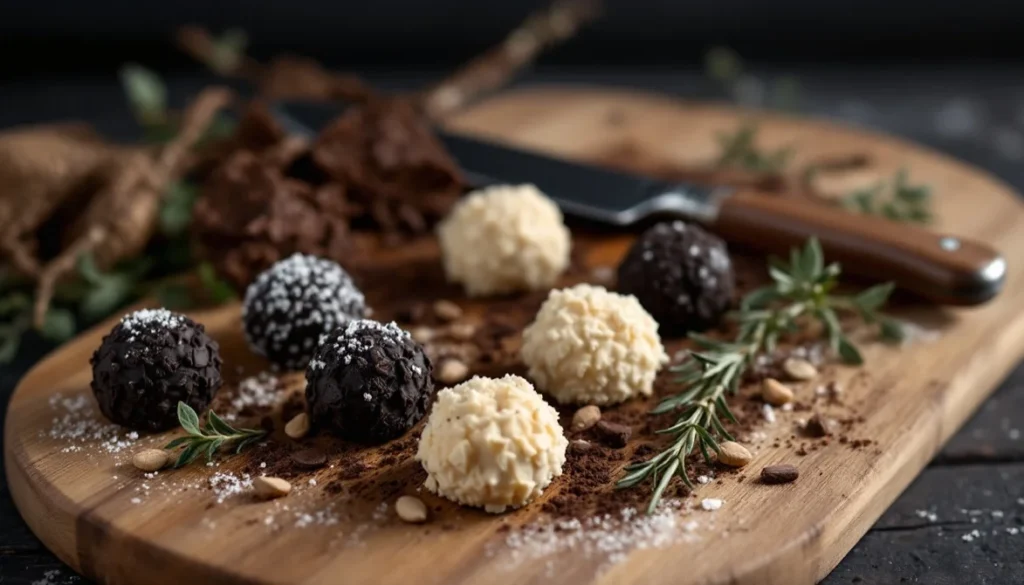What Makes a Truffle? A Culinary and Natural Wonder
Truffles are much more than an ingredient; they are also an edible treasure. They are found in the earth’s crust These fungi living underground have been revered over the centuries, not just for their unique taste but in addition to the mystery of their development. Truffles are a mixture of natural beauty and luxurious appeal. From their smoky flavor to their rareness they are a staple in gourmet and fine cooking.
The question is, what makes a truffle unique? The reason lies in their distinctive mixture of flavor, biology and historical significance. Let’s find out the ways these fungi attract foodies and chefs around the world.
What Are Truffles?
Truffles are a form of fungus which grows underground, close to the roots of certain trees, such as hazelnut and oak. They belong to a category of fungi called mycorrhizal and bacteriospores that form a symbiotic partnership with trees. As part of this relationship, truffles aid trees in absorbing nutrients from soil, and the trees provide truffles with the sugars they require to develop.
Truffles are renowned for their distinctive flavor and aroma they impart, making truffles a sought-after food. In contrast to mushrooms that can be seen above ground truffles are buried in the soil. They are a bit of an adventure, which requires experienced hunter and well-trained dogs or the pigs.
Different Types of Truffles

There are a variety of truffles. Every one having their own unique characteristic flavor and culinary uses. The most popular varieties are:
- White Truffles They are mainly found in Italy they are coveted for their strong scent and garlicky flavour. White truffles are usually eaten raw, or sprinkled on pasta or risotto in order to highlight the delicate flavor.
- black Truffles: Often called the “diamonds of the kitchen,” truffles that are black are less sour, but they have an earthy, robust flavor. They are often used in cooked dishes, such as the sauces, meats or even in cooked dishes.
- The Summer Truffles The price is lower than their winter counterparts yet nevertheless, they have a pleasing sweet, nutty flavour. Truffles from summer are an excellent introduction in the realm of truffles.
- Burgundy Truffles: Similar to summer truffles they have a stronger flavor and are often used in gourmet cuisine.
Why Are Truffles So Unique?
The distinctiveness of truffles stems from a mix of factors. The first is that their development is influenced by particular conditions that are difficult to duplicate. Truffles require the proper trees’ roots and soil, which is acidic and a perfect balance of temperature and moisture. Their natural appearance is extremely rare and unpredictably.
The taste and aroma is unlike the other ingredients. Truffles are made up of substances that give an earthy, strong scent which is usually described as musky or nuanced. This scent is what makes truffles so prized in the world of food. Even a tiny amount of truffles can make a dish go from the ordinary to exceptional.
The labor-intensive process of locating and harvesting truffles increases their appeal. Hunters depend on a trained animal to find these elusive treasures, and often spend many hours searching. This, along with their rarity, is one of the reasons truffles are sold at such a price.
Truffles Through History
Truffles have been a popular treat throughout the ages. The ancient Greeks and Romans believed that they were gifts from gods and frequently used truffles in celebrations and religious ceremonies. In during the Middle Ages, truffles were believed to be mystical and to possess medicinal properties. In the 18th century, French chefs were using truffles as an ingredient of luxury and firmly established their place as a premium ingredient.
Today, truffles be a symbol of luxury and elegance. From Michelin-starred restaurants to homes kitchens, they are an absolute favorite for foodies seeking something unique.
What Are Truffles?
What Is a Truffle?
Truffles are a kind of fungus that lives underground. They are found near the roots of trees such as oak and hazelnut. They work together with trees in a way which helps them both thrive. Truffles get nutrients from soil and give trees the sugars that they need.
As opposed to mushrooms, which are cultivated above the ground, truffles are in the shadows. They are difficult to locate. They often rely on trained pigs or dogs to find them. The most popular types are truffles that are black or white truffles. Each one has its own distinct scent and flavor.
Different Types of Truffles
There are many kinds of truffles. Black or white truffles are among the most well-known. Black truffles possess a distinct earthy, earthy taste. White truffles are famous for their sour garlicky flavor. The summer truffles and the burgundy truffles are equally well-loved. Each kind is best used when used in certain dishes, such as eggs or pasta.
Why Are Truffles So Unique?
What is it that makes truffles distinctive? They are first of all, rare. Truffles require specific trees, soil and even weather conditions in order to thrive. Additionally, their taste is unique to other truffles. They are also difficult to locate and harvest. They are the ultimate luxury food item. Truffles are more than just a food item. They are an emblem of high-end dining.
How Are Truffles Grown?
The Natural Habitat of Truffles
Truffles have a preference for where they can grow. These fungi thrive in places that have the right mix of trees, soil and climate. They’re usually found close to the root of trees such as hazelnuts, oaks, and beech trees. Truffles require soil that is calcareous–rich in limestone, and with adequate drainage. If they don’t have these, they will not develop.
The thing that makes truffles interesting is the fact that it relies on a relationship with trees. The symbiotic relationship is beneficial to both the tree and the truffle thrive. The truffle supplies nutrients to the roots of the tree while taking in sugars. This is crucial for the growth of the truffle.
Truffle-Hunting Techniques
The process of finding truffles isn’t an easy job. Since they’re underground, people depend on animals trained to detect them. Dogs are the most popular option due to their ease of train than the pigs. However, pigs were extensively used over the years because of their inherent attraction to the scent of truffles.
Hunters also need to know when to hunt. For instance truffles that are black can be located in winter, while white truffles are most abundant in the late the fall. The process takes a long time which increases the mystery and expense of truffles.
Cultivating Truffles
Truffle farming, also known as trufficulture is becoming more popular. Farmers plant a specific trees in carefully prepared soil. It can take anywhere from 5 to 10 years for the truffle farm to begin producing. Even then, the production isn’t 100% guaranteed. Truffle farming is a process that requires perseverance, expertise and good conditions.
Despite these issues The cultivation process has made truffles accessible. However, the thing that makes truffles grown by nature unique is the elusiveness and unpredictable nature of its development.

The Unique Taste and Aroma of Truffles
The Flavor Profile of Truffles
Truffles taste unlike any other. Their earthy, rich flavor is commonly described by the term an umami. This is the flavor that makes food extremely satisfying. Black truffles are famous for their rich sweet, nutty flavour. White truffles, on contrary, are more sharp with the scent of musk and garlic.
What makes the flavor of a truffle memorable is its richness. It’s not only about taste, it’s as much about aroma. Truffles emit volatile substances that increase their attractiveness. Even a tiny amount can turn a food item into something opulent.
How to Use Truffles in Cooking
Truffles are a versatile, yet delicate. For the best flavor, they’re usually drizzled over eggs, pasta or rice. They can also be infused into oils, though purists believe that nothing can compare to fresh truffles.
Because of their sour taste A little can go a long way. This is what makes truffles so special–they can enhance a dish by a couple of shavings.
Why Are Truffles So Expensive?
Scarcity and Rarity
What is it that makes truffles so costly? The answer lies in its scarceness. Truffles require a specific set of conditions to thrive. They require certain kinds of plants, particular kind of soil, as well as the ideal climate. These are the factors that create a natural truffle that is extremely rare and unpredictable. Furthermore there is a chance that not every truffle is of a high-quality and this makes them more exclusive.
Demand and Market Price
The world’s demand for truffles is far greater than their supply. Chefs and foodies around the globe are willing to pay more for this coveted ingredient. This means that the price of fresh truffles can go up to thousands of dollars for a pounds. The white truffles that are more difficult to cultivate, usually sell for more than truffles that are black.
High Cost of Production
Truffles are labor-intensive to harvest. Truffle hunters, as well as their doggies, who are trained to hunt have a long and tiring search for the hidden treasures. The cultivation of truffles also takes many years of preparation, but there is no assurance of results. The combination of work along with uncertainty and expenditure further increases the cost of their production.
To give a new spin on how to utilize truffles to make desserts like the Dark chocolate Lemon Truffles Recipe for ideas.
Myths and Misconceptions About Truffles
Common Truffle Myths
Most people think that truffles can be only available in Europe However, this isn’t the case. While some countries such as Italy as well as France are known for their truffles regions, such as those in the United States and Australia, too, produce truffles. Another myth that is commonly heard is that truffles are able to grow on their own. However, they rely on a symbiotic connection with trees.
Synthetic Truffles compare to. Real Truffles
Some of the products marketed as “truffle oil” or “truffle salt” do not contain genuine truffles. They’re usually made of synthetic compounds that mimic truffle’s scent. They’re much less expensive however they lack the sophistication of natural truffles. Knowing the distinction between real and artificial truffles is crucial to fully appreciate their worth.
If you’re looking for a way to add truffle flavor in your food go through the following non-bake recipes for truffles for a tasty dessert.
The Truffle Industry Today
Key Producers of Truffles
Truffles can be found in many regions of the globe however, a handful of regions are the dominant market. Italy as well as France are well-known because of truffles, particularly their White truffles as well as Black truffles as well. Both countries have a long history of hunting and cultivating truffles. Spain has also become the largest producers of the black truffle due to its weather and fertile soil.
Incredibly, countries such as that of United States and Australia are creating a name for themselves in the industry of truffles. Farmers from Oregon, California, and Tasmania are attempting to cultivate truffles in order to satisfy the increasing demand. This has made truffles a little more accessible however their appeal as a unique and expensive ingredient has not diminished.
The Future of Truffles
What makes the future of truffles so intriguing is the blend of innovation and tradition. Researchers and farmers are working to improve techniques for cultivation which could increase production. But the effects of climate change on the weather and soil conditions, the habitat of truffles is under threat. Research and sustainable practices will be essential in conserving the industry of truffles for the future.

FAQs on Truffles
What Are Truffles Made Of?
Truffles are fungi but their particular structure makes them unique. They are rich in protein as well as minerals and aromatic compounds. These substances give truffles their distinctive flavor and aroma. The strong scent makes truffles so sought-after when cooking, since even tiny quantities can make a difference to the flavor of a food.
Can Truffles Be Grown Anywhere?
Actually, not so much. Truffles require certain conditions to thrive. They thrive in soils with calcareous minerals they require a healthy symbiosis connection with trees such as hazelnut and oak. While truffles can be grown by farmers but it requires many years of preparation and there is no guarantee of success.
How Can You Tell a Good Truffle?
Fresh truffles must be firm and delicious. The surface must not have cracks and discoloration. A quality truffle will also have a the aroma of a pleasant, strong flavor which indicates its quality. To get the most flavor make sure to use fresh truffles as soon after purchasing.
The Culinary Impact of Truffles
How Truffles Revolutionize Dishes
Truffles are an effective ingredient in cooking. A small amount of truffles can make an ordinary food taste unique. What makes truffles distinctive is its distinct earthy and sour taste. It gives food a deeper flavor and also brings out the other flavors. Chefs frequently sprinkle truffles on pasta or risotto to give it a quick boost.
The white truffle is best eaten in their raw form. They are usually shaved over hot food items to let the aroma out. Black truffles are, however, cooked to increase their flavor. This is what makes each kind of truffle perfect for particular recipes.
Modern Uses of Truffles in Cooking
Truffles aren’t just used in fancy restaurants. Many cooks at home use truffle oil or butter or salt for the same flavor. These items allow one to taste the delicious flavor that truffles provide without paying a lot. Truffle toppings are increasingly popular on pizzas, fries, and even burgers.
In classic dishes or contemporary recipes, truffles will make your meal feel extravagant. Their distinctive taste keeps them in the forefront of the food world.
Truffles and Sustainability
Challenges in Sustainable Truffle Production
Truffles that grow sustainably are not straightforward. Truffles require specific soil, trees and the weather for growth. They are therefore prone to climate changes. Temperatures rising and extreme weather could affect their growth. What makes truffles rare is also the reason it’s fragile.
The overharvesting of truffles has also led to an increase in the production of wild truffles. To combat this farmers are implementing environmentally friendly methods. They are planting more trees, and improving the soil’s health. These measures safeguard the environment while aiding the growth of truffles.
The Role of Research and Innovation
Science is helping to solve these issues. Researchers are discovering more about the ways truffles develop. Improved farming practices have made truffle farming more secure. Research studies regarding water and soil management help farmers grow more truffles, while also protecting the environment.
Combining innovation and tradition is the secret to sustainable truffles. Through these efforts, the truffle can be an excellent culinary treat for many in the foreseeable future.

